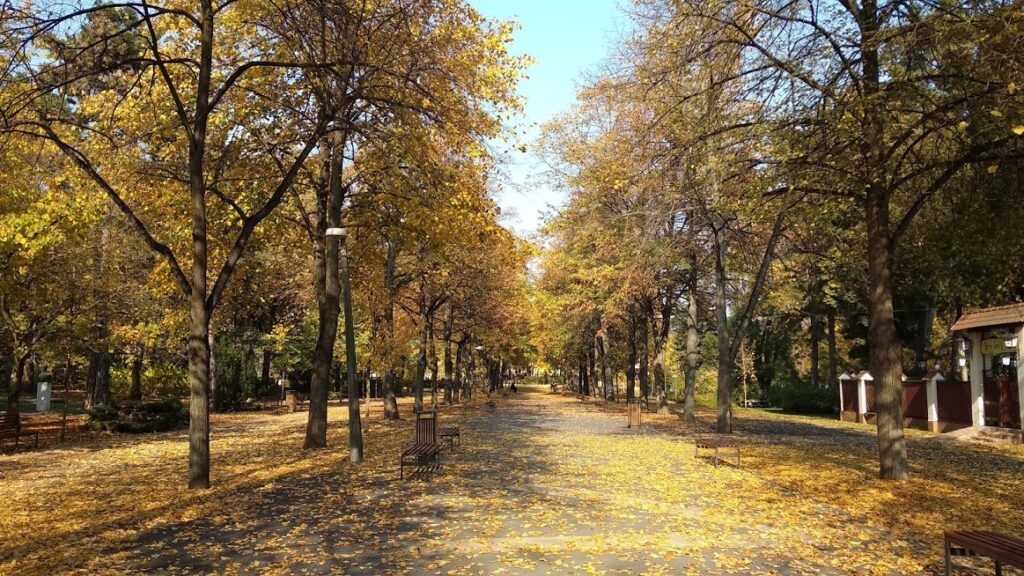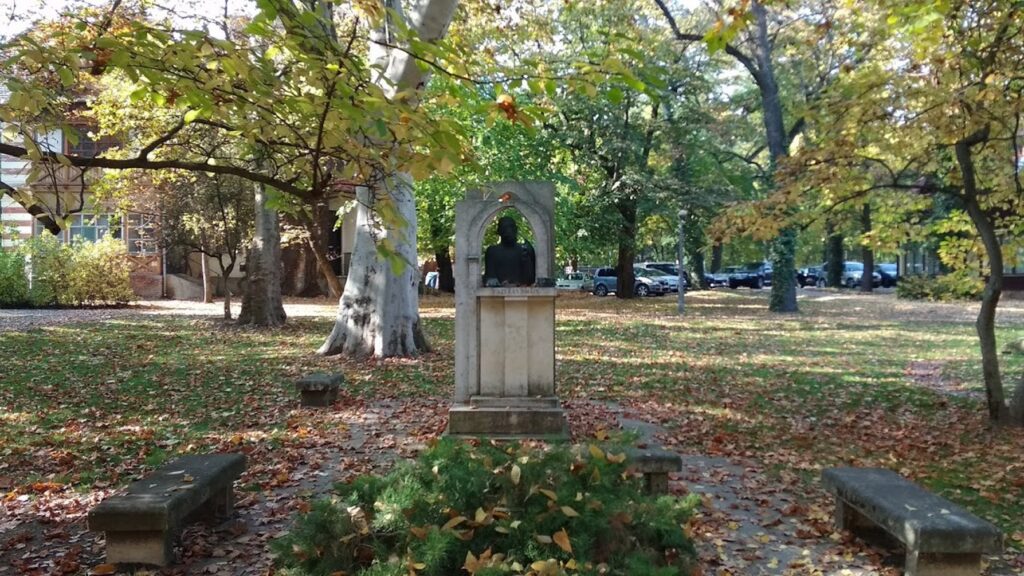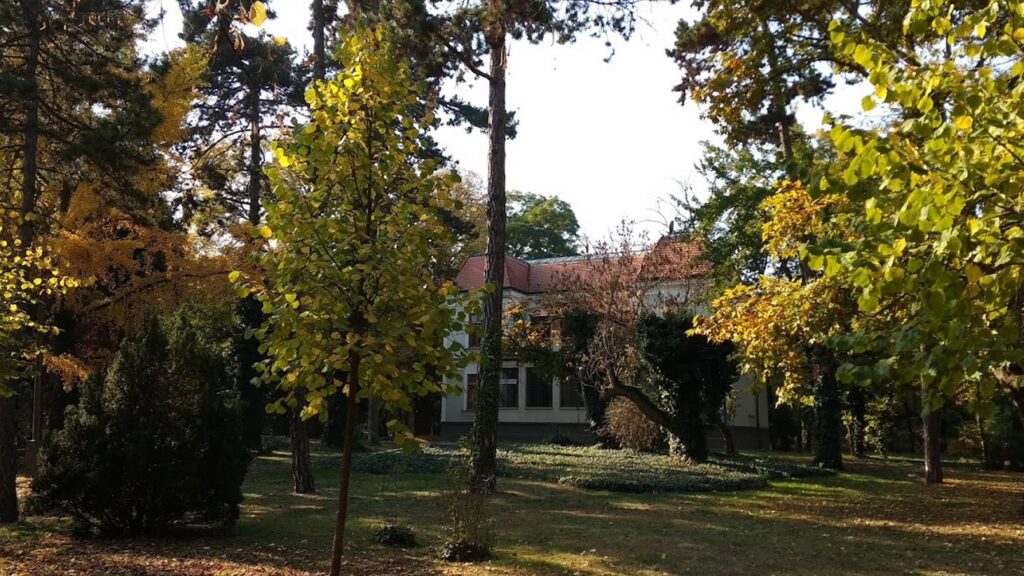The Medgyessy promenade, located at the entrance of the Great Forest is by far the most appealing entrance to the Great Forest, especially now with the Autumn colours. This spot was frequented by talented poets, authors, and scientists. The forest the promenade leads to provided several research topics for scientists. István Hatvani, a famous professor of European significance often looked for plants with curative effects here.
Some of the greats of Hungarian literature, such as Mihály Csokonai Vitéz, Endre Ady, and Zsigmond Móricz frequented Medgyessy promenade. Several sculptures pay tribute to them in the literary sculpture park located on each side of the Medgyessy Promenade.

The sculpture park includes tributes to:-
Mihály Csokonai Vitéz
Learn more about Mihály Csokonai Vitéz and the other famous writers mentioned here at the Debrecen House of Literature & Medgyessy Ferenc Memorial Museum (part of the Déri Museum).
Endre Ady
The monument to Endre Ady on Medgyessy promenade was made by Miklós Melocco in 1977.
Zsigmond Móricz
The prominent Hungarian writer studied Theology and then Law at Debreceni Református Kollégium (1891–1893). His novels predominantly deal with issues of poverty of the Hungarian peasantry of the times.
Mihály Fazekas
Born and raised in Debrecen Mihály Fazekas’ was a writer who served in the war but despised violence. His work highlighted the social injustice of the times.

This monument to Mihály Fazekas was created by Edit Rácz 1977.
János Arany,
A prolific writer, poet, and journalist that is known for his Hungarian ballads, of which he wrote 102.
The bust of János Arany was made by Ferenc Medgyessy, a Kossuth Prize-winning sculptor, but due to the artist’s illness, his pupil Megyeri Barna, a Munkácsy Prize-winning artist, completed the sculpture in 1957.
Gyula Krúdy,
Born in Nyíregyháza he worked as an editor at several local newspapers including in Debrecen, he wrote several adventure series, including Sinbad’s Youth, (1911), much later to be translated into English under the title “The Adventures of Sinbad” in 1998 by Central European University Press. Several other of his works were also translated into English in later years.
The bust of Gyula Krúdy was made by Tamás Vígh, a Munkácsy Prize-winning sculptor.
Árpád Tóth
A poet whose work reflected poverty and the sickness that he was afflicted by. He started out life attending school in Debrecen. Tuberculosis ultimately led to his demise in 1928. A detailed account of his life and works can be found here.
Bust of Árpád Tóth, created by Miklós Borsos, Kossuth and Munkácsy Prize-winning sculptor, in 1977.
Lőrinc Szabó
Another poet that began life with schooling in Debrecen, he went largely unknown during most of his life even though he was first published in 1922 Föld, erdő, Isten (“Earth, Forest, God”) achieved considerable success, however in later years he was sidelined because of his right-wing views. Just before his death, he was recognized for his contribution to Hungarian literature when he was awarded the Kossuth Prize.
The Lőrinc Szabó monument, created by Erzsébet Schaár Munkácsy Prize-winning sculptor 1966.
Pál Gulyás
A poet and well-known lyricist, born in Debrecen in 1899 and attended the Debrecen Reformed college like many famous poets and writers listed here. He famously opposed the German-Italian foreign policy. He died 5 months prior to the battle of Debrecen in 1944 during World War 2 aged just 44.
Despite dying at such a young age he was accomplished as a writer and as a linguist, speaking Finish, Icelandic, Ancient Greek, and Romanian. He was a founding member of the Ady Society in Debrecen, (see above about Endry Ady).
The statue of Pál Gulyás was created by sculptor Tibor Vilt in 1977.
Wass Albert Monument
The Wass Albert Monument, created by Sándor Györfy in 2008. The statue caused much consternation, due to the writer’s controversial work.
The statue of Ferenc Medgyessy after whom the promenade was named, was created by Sándor Nagy in 1977.
Millennium plaque, made by Munkácsy Prize-winning sculptor Árpád Somogyi in 2000.
Visit the Debrecen House of Literature & Medgyessy Ferenc Memorial Museum
The history of the promenade is also part of the history of the great villas that line the Simonyi Ut, and more specifically the Summer Villas that line one side of the Medgyessy promenade.

Nagyerdei Villa
In 2008 renovation began on these “Summer Villas”, one of which was converted into apartments.
Towards the beginning of the promenade leading to the park and opposite the aforementioned apartments is a war memorial, commemorating those who died fighting in the war for Debrecen or in the vicinity during World War II.